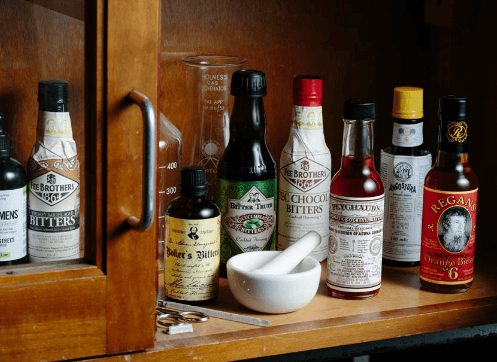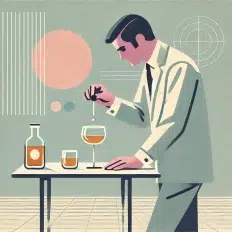For anyone trying to give their drinks a little something extra, cocktail bitters could be the secret ingredient you’ve been searching for. These unique flavorings have been around for centuries but are now making a comeback in trendy bars and restaurants. But what are cocktail bitters, and how do you use them? In this article, we’ll explore the history of cocktail bitters and how you can use them to enhance the flavor of your favorite beverages.
What Are Cocktail Bitters?
Cocktail bitters are an alcoholic infusion made from a combination of herbs, spices, and botanicals. They come in a variety of flavors, from the classic Angostura to the more exotic cardamom bitters, and are used to add complexity, depth of flavor, and balance to cocktails. Bitters are usually used as dashes or drops instead of as a main ingredient, and they can be used to complement or contrast the flavor of a drink. Bitters can also be used to create unique flavor combinations, such as the classic Old Fashioned, which uses angostura and orange bitters.
What Drinks Are Cocktail Bitters Used In?
Cocktail bitters are an essential ingredient in the world of mixology. As their name suggests, they are a type of liquid that tastes bitter and is often added to cocktails to make them taste and smell better. The main purpose of using bitters in a cocktail is to add complexity and balance to the flavor. Bitters come in a wide variety of flavors and can be used as an accent or to provide a unique flavor profile to a cocktail.
Bitters are a type of flavoring agent that has been used in cocktails since the 19th century. They are made from a variety of herbs, spices, and fruits and are often infused with alcohol to create a concentrated extract. The most common bitters used in cocktails are Angostura and Peychaud’s. These two brands are perhaps the most famous, but there are now many other bitters available, including orange, lemon, and ginger.
Bitters are usually added to a cocktail in a few drops, as a few drops of bitters can go a long way. Bitters can be added to almost any cocktail to make it taste better, from the classic Martini to the Margarita. The most popular cocktails that use bitters are the Manhattan, Old Fashioned, and Negroni. All of these cocktails call for a few drops of Angostura bitters. Other cocktails that use bitters include the Sazerac, which calls for Peychaud’s bitters, and the Boulevardier, which uses orange bitters.
Bitters can also be used to add a unique flavor to drinks that are not traditionally made with bitters. For example, adding a few drops of Angostura bitters to a glass of sparkling wine or ginger beer can give the beverage an interesting flavor. Bitters can also be used to make a variety of mocktails and non-alcoholic drinks.
In addition to being used in cocktails, bitters can also be used in cooking and baking. A few drops of bitters can be added to a variety of dishes and desserts for a unique flavor. For example, adding a few drops of orange bitters to a cake or a tart can give it a unique flavor.
Bitters are an important part of mixology and can be added to almost any cocktail to make it taste better. They are also a great way to add a unique flavor to dishes and desserts. Bitters come in a variety of flavors, from classic Angostura to more exotic flavors such as ginger and orange. A few drops of bitters can go a long way and can be used to turn a simple drink into something special.
Do Cocktail Bitters Go Bad?
Bitters are made by steeping herbs, roots, barks, and spices in a solution of alcohol and water. The alcohol acts as a preservative, so the bitters will last for a long time if stored properly. Bitters have a shelf life of around three years, but this varies depending on the type of bitters and the quality of the ingredients.
When storing your bitters, it’s important to keep them in a cool, dry place away from direct sunlight and humidity. This will help to ensure that the flavoring ingredients don’t degrade over time. It’s also important to make sure that the bottle is tightly sealed so that no air can get in and cause the bitters to go bad.
If you’re not sure how old your bitters are, you can check the expiration date on the bottle. If there is no expiration date, you can guess how long they have been open. Generally, the rule of thumb is that bitters should be used within six months of opening.
If your bitters are past their expiration date or if they’ve been open for more than six months, it’s best to discard them. This is because the flavor of the ingredients will have changed over time, resulting in less than optimal flavor for your drinks.
How Many Types Of Cocktail Bitters Are There?
The answer is: it depends. There is no single definitive answer, as the range of bitters available can vary from cocktail bar to cocktail bar and from country to country. Most cocktail bars will likely stock at least a few types of bitters, while more specialized establishments may carry a far wider range. In general, though, cocktail bitters fall into six main groups: aromatic, citrus, herbal, floral, spicy, and fruit.
Aromatic bitters are the most popular and versatile and are often used as a base for many drinks. Examples of aromatic bitters include Angostura, Peychaud’s, and Regan’s. Citrus bitters are made with dried and crushed citrus peels and are used to add a zesty and tart flavor to a drink. Popular citrus bitters include orange and lemon. Herbal bitters are made from different herbs, spices, and roots, and they give a cocktail a unique flavor. Examples of herbal bitters include Fee Brothers and the Bitter Truth.
Floral bitters are made from dried flowers, fruits, and other botanicals and are used to create a subtle floral aroma and flavor in drinks. Spice bitters are made from a variety of spices, such as cardamom, cinnamon, and allspice, and are used to add a spicy kick to a cocktail. Cardamom bitters from The Bitter Truth and Fee Brothers West Indian Orange bitters are two popular spice bitters. Lastly, fruit bitters are made from a variety of fruits and are used to add a fruity flavor to a drink. Popular fruit bitters include The Bitter Truth’s apricot and Fee Brothers’ cranberry.
With so many different types of bitters available, it can be overwhelming trying to decide which ones to use. However, with a little bit of experimentation, you can find the perfect combination of flavors for any drink. And don’t forget: even if you don’t have all of the different types of bitters, a few bottles of the most popular ones will go a long way in creating great cocktails.

Are Cocktail Bitters Gluten-free?
The ingredients found in bitters typically don’t contain gluten, so there’s no need to worry about these spirits for the most part. However, it’s important to read the label on each bottle of bitters to check for any potential allergens, as some bitters may contain trace amounts of wheat or gluten-based ingredients.
The base of most bitters is typically alcohol, with other ingredients like herbs, spices, and fruits added to create a unique flavor. Since alcohol is made from grains such as barley, wheat, and rye, it may contain gluten. But since alcohol is distilled, the gluten proteins are broken down, leaving the finished product gluten-free. In addition, many brands of bitters use alcohol that has been specifically produced to be gluten-free, so it’s always a good idea to double-check the label on each bottle of bitters to make sure.
Aside from the alcohol, most of the other ingredients in bitters are also gluten-free. Spices such as cinnamon, nutmeg, and cardamom are gluten-free, as are herbs like lavender, rosemary, and mint. Most fruits are also gluten-free, so it’s safe to say that most bitters don’t contain gluten.
The one exception to this rule is aromatic bitters, which are made with a grain-based alcohol and often contain wheat or rye. It’s important to read the label on each bottle of aromatic bitters to make sure it’s gluten-free, as some brands may use gluten-containing grains in their production process.
To sum it all up, in most cases, cocktail bitters are gluten-free. However, it’s always a good idea to double-check the label on each bottle of bitters to make sure. Aromatic bitters often have wheat or rye in them, so people who are sensitive to gluten shouldn’t use them. But for the most part, bitters are a great way to add flavor to your favorite cocktails without having to worry about gluten.
Cocktail Bitters: Who Created Them?
Bitters were first used in the 18th century by Dr. Abraham Back, a Swedish scientist who believed in the use of medicinal tonics and made a mixture of herbs and spices to treat different illnesses. This tonic was known as “Bäck’s Bitters” and is believed to be the first use of the term “bitters.”
In the 19th century, bitters moved from being a medicinal tonic to a popular ingredient in cocktails. Around this time, a man named George A. Schiller, a German immigrant and owner of a pharmacy in New York City, invented a combination of herbs and spices known as “Schiller’s Bitters.” Schiller’s Bitters quickly became a popular ingredient in many classic cocktails, like the Manhattan, Old-Fashioned, and Sazerac.
As cocktail culture grew, so did the demand for different types of bitters. In the early 20th century, a number of companies began to produce their own versions of bitters. Some of the most popular brands of bitters include Angostura and Peychaud’s, both of which are still widely used today.
Even though no one knows for sure who invented cocktail bitters, bitters have been used to add flavor to drinks since the 18th century. Bitters are now an important part of many classic cocktails, and the type of bitters used can often change the taste of a drink. As such, the person or persons responsible for inventing cocktail bitters have had a huge impact on modern-day bar culture.
Conclusion
Cocktail bitters are a versatile and flavorful addition to any bar. They can be used to create unique flavor combinations as well as to add complexity and balance to your favorite drinks. Since there are so many different kinds of bitters, you can try out different flavors to find the right mix for your signature drink. From a classic Old Fashioned to a modern twist on a classic, a few drops of bitters can make all the difference in your drink. So next time you’re looking to add a little something extra to your drinks, reach for the bitters and see what you can create.




